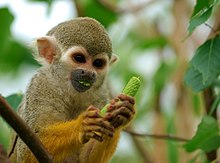Monkeys range in size from the pygmy marmoset,
which can be as small as 117 millimetres (4.6 in) with a 172-millimetre
(6.8 in) tail and just over 100 grams (3.5 oz) in weight,[10] to the male mandrill, almost 1 metre (3.3 ft) long and weighing up to 36 kilograms (79 lb).[11] Some are arboreal (living in trees) while others live on the savanna;
diets differ among the various species but may contain any of the
following: fruit, leaves, seeds, nuts, flowers, eggs and small animals
(including insects and spiders).[12]
Some characteristics are shared among the groups; most New World monkeys have prehensile tails while Old World monkeys have non-prehensile tails or no visible tail at all. Old World monkeys have trichromatic color vision like that of humans, while New World monkeys may be trichromatic, dichromatic, or—as in the owl monkeys and greater galagos—monochromatic. Although both the New and Old World monkeys, like the apes, have forward-facing eyes, the faces of Old World and New World monkeys look very different, though again, each group shares some features such as the types of noses, cheeks and rumps.[12]
The following list shows where the various monkey families (bolded)
are placed in the classification of living (extant) primates.
In some areas, some species of monkey are considered agricultural pests, and can cause extensive damage to commercial and subsistence crops.[13] This can have important implications for the conservation of endangered species, which may be subject to persecution. In some instances farmers' perceptions of the damage may exceed the actual damage.[14] Monkeys that have become habituated to human presence in tourist locations may also be considered pests, attacking tourists.[15]
In religion and culture, the monkey often represents quick-wittedness and mischief.
Some characteristics are shared among the groups; most New World monkeys have prehensile tails while Old World monkeys have non-prehensile tails or no visible tail at all. Old World monkeys have trichromatic color vision like that of humans, while New World monkeys may be trichromatic, dichromatic, or—as in the owl monkeys and greater galagos—monochromatic. Although both the New and Old World monkeys, like the apes, have forward-facing eyes, the faces of Old World and New World monkeys look very different, though again, each group shares some features such as the types of noses, cheeks and rumps.[12]
Classification
| Phylogeny of living (extant) primates | |||||||||||||||||||||||||||||
|
|||||||||||||||||||||||||||||
| Monkeys (in green brackets) are a paraphyletic group, since they exclude hominoids. |
- ORDER PRIMATES
- Suborder Strepsirrhini: lemurs, lorises, and galagos
- Suborder Haplorhini: tarsiers, monkeys, and apes
- Infraorder Tarsiiformes
- Family Tarsiidae: tarsiers
- Infraorder Simiiformes: simians
- Parvorder Platyrrhini: New World monkeys
- Family Callitrichidae: marmosets and tamarins (42 species)
- Family Cebidae: capuchins and squirrel monkeys (14 species)
- Family Aotidae: night monkeys (11 species)
- Family Pitheciidae: titis, sakis, and uakaris (41 species)
- Family Atelidae: howler, spider, and woolly monkeys (24 species)
- Parvorder Catarrhini
- Superfamily Cercopithecoidea
- Family Cercopithecidae: Old World monkeys (135 species)
- Superfamily Hominoidea: apes
- Family Hylobatidae: gibbons ("lesser apes") (17 species)
- Family Hominidae: great apes including humans (7 species)
- Superfamily Cercopithecoidea
- Parvorder Platyrrhini: New World monkeys
- Infraorder Tarsiiformes
Relationship with humans
The many species of monkey have varied relationships with humans. Some are kept as pets, others used as model organisms in laboratories or in space missions. They may be killed in monkey drives (when they threaten agriculture) or used as service animals for the disabled.In some areas, some species of monkey are considered agricultural pests, and can cause extensive damage to commercial and subsistence crops.[13] This can have important implications for the conservation of endangered species, which may be subject to persecution. In some instances farmers' perceptions of the damage may exceed the actual damage.[14] Monkeys that have become habituated to human presence in tourist locations may also be considered pests, attacking tourists.[15]
In religion and culture, the monkey often represents quick-wittedness and mischief.


No comments:
Post a Comment